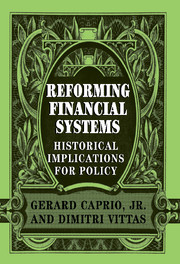Book contents
- Frontmatter
- Contents
- List of contributors
- Foreword
- 1 Financial history: Lessons of the past for reformers of the present
- 2 The evolution of central banking
- 3 Free banking: The Scottish experience as a model for emerging economies
- 4 Regulation and bank stability: Canada and the United States, 1870–1980
- 5 Deposit insurance
- 6 Contingent liability in banking: Useful policy for developing countries?
- 7 Universal banking and the financing of industrial development
- 8 Before main banks: A selective historical overview of Japan's prewar financial system
- 9 Thrift deposit institutions in Europe and the United States
- 10 The development of industrial pensions in the United States during the twentieth century
- 11 The rise of securities markets: What can government do?
- Index
5 - Deposit insurance
Published online by Cambridge University Press: 25 March 2010
- Frontmatter
- Contents
- List of contributors
- Foreword
- 1 Financial history: Lessons of the past for reformers of the present
- 2 The evolution of central banking
- 3 Free banking: The Scottish experience as a model for emerging economies
- 4 Regulation and bank stability: Canada and the United States, 1870–1980
- 5 Deposit insurance
- 6 Contingent liability in banking: Useful policy for developing countries?
- 7 Universal banking and the financing of industrial development
- 8 Before main banks: A selective historical overview of Japan's prewar financial system
- 9 Thrift deposit institutions in Europe and the United States
- 10 The development of industrial pensions in the United States during the twentieth century
- 11 The rise of securities markets: What can government do?
- Index
Summary
Despite its imperfections, the U.S. financial system remains a very attractive model for architects of financial systems in developing countries and transition economies. The U.S. system efficiently transfers and redistributes funds from one sector to another with a high degree of safety and soundness. Of all the U.S. financial system's components, the banking sector is perhaps the weakest. And yet even this part of the system may look good to developing countries and policy makers.
The U.S. banking sector includes all the institutions that take deposits and make loans, including commercial banks, savings and loans, savings banks, and credit unions. To examine the development of deposit insurance and its role in the performance of the U.S. banking sector, it is important to focus on the big picture: the banking sector in the United States has become less important over time. Relative to other parts of the financial system, the banking sector has undergone a very slow and almost steady contraction throughout the twentieth century. For example, in 1900 commercial banks held approximately two-thirds of the assets of all financial intermediaries. This ratio has fallen steadily, and today commercial banks hold less than one-third of these assets. Although several factors underlie this decline and the movement of much activity off balance sheet, the leading factor has been regulation. Regulation has come from both the federal government and state governments. It has constrained the expansion of banks and contributed to the widespread failure of individual institutions.
This chapter analyzes the role of deposit insurance in depository institutions, focusing on commercial banks.
- Type
- Chapter
- Information
- Reforming Financial SystemsHistorical Implications for Policy, pp. 85 - 100Publisher: Cambridge University PressPrint publication year: 1997
- 7
- Cited by



